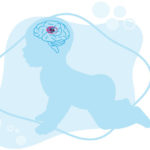Writing the book on infantile spasms: Charlotte’s story

When Charlotte, 3, developed infantile spasms last year, her parents, Kate and Brett, entered a world they didn’t know how to navigate.
Inspired by their daughter and the care she received at the Epilepsy Center at Boston Children’s Hospital, they set out to help other families facing similar experiences.
Nervous parent instincts prove right
“I was definitely a nervous first-time mom,” Kate admits.
Her nerves may have been on to something though, because right before Charlotte’s second birthday, she started having strange but subtle movements — movements that looked like arm-raising and head bobs.
Kate looked up Charlotte’s symptoms but didn’t find much that matched what she was doing. Kate also recorded the movements to show Charlotte’s pediatrician, who assured her that Charlotte was developing well and meeting all her milestones. Still, Kate couldn’t shake her doubt.
“Something about it just didn’t sit right with me,” she says.
Kate requested a referral to a neurologist. The appointment was a turning point.
Immediately upon watching the videos, Charlotte’s neurologist confirmed that she was experiencing infantile spasms, a rare type of seizure that usually presents within the first year of life; Charlotte’s were considered late onset. Infantile spasms involve sudden, brief muscle contractions or jerking movements and are often accompanied by an abnormal EEG pattern.
“That was the first time that we had ever heard that term,” Kate says.
Not a moment to waste

When an EEG confirmed infantile spasms, the neurologist referred them right away to Boston Children’s. At that time, Kate was nearly nine months pregnant with her second child, and the diagnosis was a lot to process. They considered waiting until after the baby arrived to pursue further testing or treatment, but the doctor pressed them on the urgency.
If left untreated, infantile spasms can cause developmental and cognitive problems. Looking back, Kate thinks maybe there was a correlation between Charlotte’s spasms and a delay in her language development. As first-time parents though, and being unfamiliar with infantile spasms, Kate and Brett couldn’t be sure. In addition, Kate adds, they could have easily dismissed Charlotte’s because they were so subtle.
“It feels like you’re overreacting,” she says. “You feel like you sound crazy when you bring it up as a concern.”
Support during uncertainty
When Charlotte arrived at Boston Children’s, she was immediately admitted to the Epilepsy Monitoring Unit for further testing. The tests revealed that Charlotte had focal cortical dysplasia, a condition characterized by disorganized, abnormal cell development in the top area of the brain, the cortex. Treatment for focal cortical dysplasia focuses on controlling a child’s seizures and can be done with medication, a ketogenic diet, or surgery. Kate credits Charlotte’s neurologist, Dr. Chellamani Harini, and the Boston Children’s team for keeping her and Brett calm and focused as they navigated the options.
“I can’t say enough about Boston Children’s,” Kate says. “They did such a great job of balancing the facts of her condition with weighing what was best for Charlotte.”
Dr. Harini and the Epilepsy Center team determined that medication was the best course for Charlotte and initiated a treatment regimen. Today, Charlotte is seizure-free and weaning off medication, and Kate and Brett feel like they have their daughter back.
“Her development completely took off,” Kate says. “With her spasms gone, we saw such a difference in her language and vocabulary. Her attention, emotions, and overall interactions are back to being like the little girl we knew before.”
Paying it forward on pages
Today, as Charlotte talks up a storm and enjoys school and playing with her little brother, Kate and Brett think back to last year and what a scary and confusing time it was. Kate is grateful for the people she met through the experience and hopes to be a similar source of support for other families.
She decided to write a children’s book to promote awareness, action, and advocacy for infantile spasms and worked with members of the Epilepsy Center clinical team to put it together.
“The people we met through this journey have been a true silver lining,” Kate says. “We’re so lucky that we have Boston Children’s, and that Charlotte has received the care she has. I wanted to capture what we’ve learned about infantile spasms and share it with others because I want them to know there is hope.”
Learn more about the Epilepsy Center at Boston Children’s Hospital or request a second opinion.
Related Posts :
-

Tuber locations associated with infantile spasms map to a common brain network
About half of all babies with tuberous sclerosis complex (TSC) develop infantile spasms, a type of epilepsy that can have ...
-

A family’s search for answers and hope for PACS1 syndrome
Alya, 9, was about three weeks old when her mother, Taruna, noticed movements and behaviors she was concerned might be ...
-

A model patient: Alexia’s triumph over moyamoya disease
If you’re lucky enough to get time on Alexia’s packed schedule, you’re in the company of a ...
-

A promising new antiseizure drug tailored to newborns
Neonatal seizures can lead to serious consequences, including significant cognitive and motor disabilities, lifelong epilepsy, and death. They are ...





